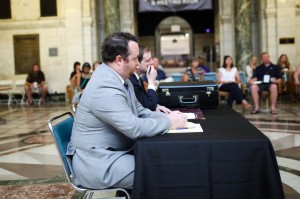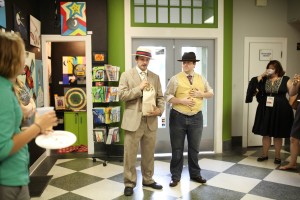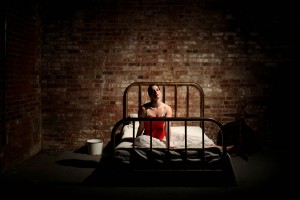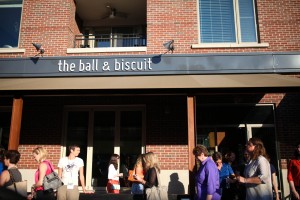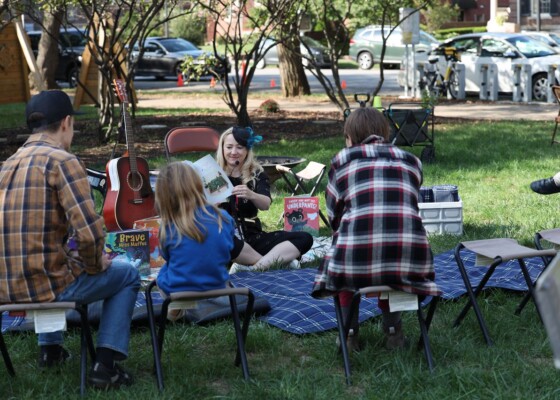Crime, Alcohol, and…..the Humanities?
June 30, 2014While crime and alcohol are not an uncommon pairing, it is usually rare to find them grouped with the humanities. Yet Indiana Humanities recently did just that, when we put…
While crime and alcohol are not an uncommon pairing, it is usually rare to find them grouped with the humanities. Yet Indiana Humanities recently did just that, when we put on a Crime and Punishment themed historic bar crawl. This is the second year for our historic bar crawl in Indianapolis, but this year’s theme took participants to new locations and featured murder, mayhem and yes, even a little debauchery. It was also such a popular event, we decided to offer it for two nights (see photos)! (You can read more about why we originally decided to plan a bar crawl in a blog post from former intern Jenny Kalvaitis).
On June 3 and 4 participants traveled to four different locations around Mass Ave, after kicking off the night at the eerie catacombs under City Market. Each stop paired beer (thanks Sun King!) with historic interpreters (thanks Indiana Historical Society!) to tell a unique crime and punishment story from the city’s history. This year’s crawl featured the following stories and locations:
Old City Hall- The Trial of D.C. Stephenson
At Indianapolis’ Old City Hall (now The Hall), local trial lawyers reenacted a condensed version of closing arguments from the trial of D.C. Stephenson. Stephenson rose to prominence in the influential Indiana KKK during the 1920s. On March 15, 1925 Stephenson raped and brutally attacked Madge Oberholtzer. Madge attempted suicide by taking a large quantity of pills. The wounds from his attack weakened her resistance to the pills she took, and Madge eventually died, despite receiving medical attention. Stephenson was found guilty of second degree murder because he failed to get immediate help for Madge. The trial took place in Hamilton County but Madge and Stephenson were both Indianapolis residents. After the conviction, Stephenson expected his political friends to pardon him. When no pardon came, Stephenson released incriminatory evidence on top Indiana officials, including Mayor Duvall of Indianapolis. Stephenson’s imprisonment helped lead to the end of the KKK’s popularity in Indiana.
Further Thought: When is a political pardon appropriate?
Further Reading: Grand Dragon: D.C. Stephenson and the Ku Klux Klan in Indiana by M. William Lutholtz
Citizen Klansmen: The Ku Klux Klan in Indiana, 1921-1928 by Leonard J. Moore
The Art Bank Gallery – Dillinger Bank Robbery
The Art Bank Gallery (located on Mass Ave.) featured a re-enanctment of a John Dillinger bank robbery. John Dillinger was born in Indianapolis and is one of America’s most celebrated and notorious gangsters. On Sept. 6, 1933 John Dillinger robbed the State Bank of Massachusetts Ave (Art Bank Gallery’s current location). Dillinger entered the bank, leapt over the teller barrier and demanded the teller fill sacks of money at gunpoint. He happened to hit the bank on the payroll day of the nearby Real Silk Hosiery. He walked away with $24,800, his largest bank robbery at that point.
Further Thought: Do we glorify criminals?
Further Reading: Hard Times: An Oral History of the Great Depression by Studs Terkel
Public Enemies: America’s Greatest Crime Wave and the Birth of the FBI, 1933-34 by Bryan Burrough
Pizzology – Resort
A 1910s brothel was set-up in the basement of the recently opened Pizzology on Mass Ave. In the early 1900s, brothels were referred to as “resorts” and the ladies who occupied them were known as “inmates.” During this time, Indianapolis struggled to determine the local government’s role regulating the resorts. Beginning in 1910, Mayor Shank faced pressure to shut down the resorts downtown. Shank resisted because he believed the women would move into “more respectable areas.” Instead, he instated stricter rules that included forbidding resorts to sell alcohol. In 1912, facing impeachment, Shank agreed to shut down the city’s resorts, but the measure was difficult to enforce and prostitution persisted.
Further Thought: Should we legislate morality?
Further Reading: The Lost Sisterhood: Prostitution in America, 1900-1918 by Ruth Rosen
The Ball & Biscuit – FBI Top 10 Take-Down
At the Ball & Biscuit, two actors portrayed the take-down of Henry Harland Shelton at an Indianapolis tavern. In 1950 the FBI released the first “Ten Most Wanted Fugitives” list with Henry Harland Shelton at #9. Shelton (born in Indianapolis in 1909) escaped from the Michigan State Prison after an arrest for bank robbery, and then stole cars around the Midwest and robbed several stores. His appearance on the list led to tips on the places Shelton was known to frequent in Indianapolis. On June 23, 1950 the FBI apprehended Shelton at a tavern on Michigan Street. When Shelton reached for a gun, two agents fired and hit Shelton. As they waited for the ambulance, he was allowed to drink and smoke a cigarette. The federal court sentenced Shelton to 45 years in Leavenworth prison.
Further Thought: Would you provide a tip on a fugitive?
Further Reading: Enemies: A History of the FBI by Tim Weiner
Re-creating some of Indianapolis’ shadier past reminds us that there’s a fine line between understanding and glamorizing crimes and criminals, both in the past and the present. But, if we ignore the difficult parts of history, we miss an opportunity to wrestle with important but difficult questions. The format of learning about history through an unconventional program (a bar crawl) gave us an opportunity to break down barriers and remind people that learning can be fun! We viewed this event as a way to help people get started thinking and talking and we hope the conversations have continued.
Join the conversation about crime, alcohol, and the humanities in Indianapolis – Comment below or tweet us @INHumanities #historicbarcrawl
Written by Christine Crosby, a graduate intern with Indiana Humanities. Christine is currently finishing her thesis for her Master’s degree in Public History.
